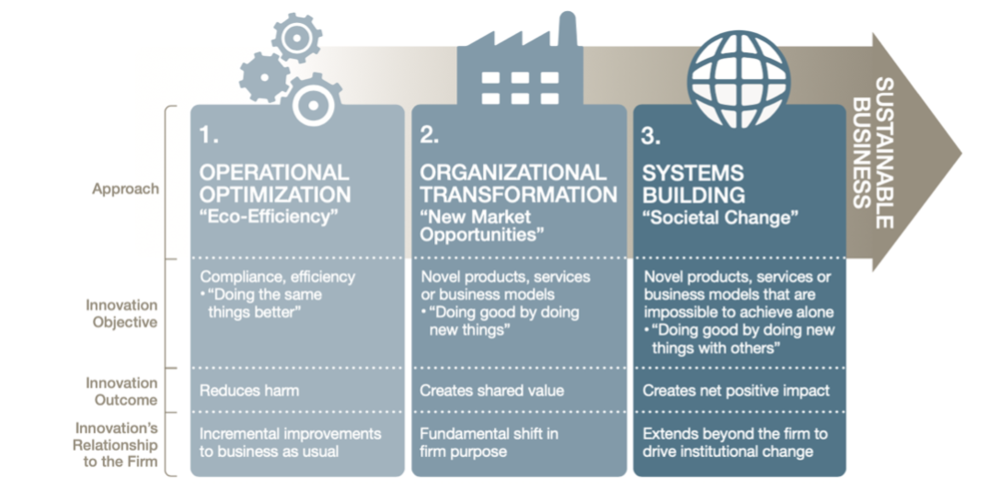Sustainable Innovation in Businesses
Sustainability is the idea that goods and services should be produced in ways that use resources that can be replaced and without damaging the environment. Sustainability can also be viewed upon as minimizing the use of resources that cannot be replaced.
Innovation is all about creativity and novelty. An innovation often results in new products, services or processes.
Sustainable innovation couples these two concepts. It involves leveraging ideas, concepts, and products that achieve economic viability due to environmentally aware designs and practices. As per researcher Richard Adams (Network for Business Sustainability 17 May 2015), this can be possible by making deliberate and planned changes to a company’s products, services, or processes to generate long-term social and environmental benefits alongside creating economic profits for the organisation. It is innovation that serves public good, and is receiving greater attention even from the corporate world. Sustainable innovation serves sustainable development goals, helping create shared value, along with delivering commercial value creation.
Differences between sustainable innovation and traditional innovation
Innovation has been a buzzword for quite some time now, in various fields, be it in medicine, aviation, IT, education, services and so on. An analysis of sustainable and traditional innovation, led us to the distinction as summarized in the below table:

https://innovationmanagement.se/2017/04/18/five-ways-sustainable-innovation-is-different-from-normal-innovation/#:~:text=Five%20Differences%20with%20Sustainable%20Innovation,solution%20for%20customers%20and%20business
Sustainable innovation can at times be disruptive and it can result in better business models, improved processes, streamlined resource flows, reduced waste and cost, and create new market segments entirely, making it harder for corporations to defend the status quo. As consumers gain more knowledge on sustainability their preferences change and prefer to consume products and services that align with sustainable principles. Whether it’s fair working conditions or climate change, metrics are used to determine how ethical and sustainable an organization is and a key factor for consumers in choosing whether to support a business.
Why should businesses innovate sustainably?
Today, sustainability is the key driver of innovation. Incorporating sustainable practices can lower costs and increase revenues. In the future, companies that incorporate sustainable goals will achieve competitive advantage.
Challenges in innovating sustainability
Despite the benefits, pursuing sustainable innovation has its challenges. Achieving it takes time, commitment, and effort.
The following factors broadly represent the challenges in sustainable innovation.
- Declining resources: Shrinking size of mature markets or lack of availability of new markets could contribute to the challenges.
- Technical challenges and market reactions: Getting right the critical balance between scale, reliability, and cost
- Regulatory, political, cost and supply chain uncertainties
Understanding these (and other challenges) becomes the first step to crafting an innovation strategy that fits the organisational efforts.
Ways to successfully innovate sustainably
Sustainable innovation can fall under the following broad categories:
- Operational optimization
- Organizational transformation, and
- Systems building
Researcher Richard Adams and colleagues identified these different categories. They represent a continuum in terms of impact, with “systems building” creating the greatest change.

https://www.nbs.net/articles/what-is-sustainable-innovation-and-how-to-make-innovation-sustainable
Other ways to innovate sustainably are:
- Changing operational processes. Sustainable innovation isn’t always inventing products/services but offering existing ones with changed processes. For e.g. design, production, marketing, and even HR. Fairphone, a Dutch social enterprise, changed production process using recycled and responsibly mined materials, providing workers fair wages and good labour conditions. Their modular design makes repairs and upgrades easier for reducing e-waste.
- Expand the business canvas by mapping the wider ecosystem of stakeholders and societal issues in which the business operates.
- Analyze future trends and build scenariosto envision different, versions of the future. Use these scenarios to predict how might environmental and societal issues change over time and the effects of these issues on the business model.
- Explore scaling up the business. Imagine the business model at different scales of activity over a longer span of period. Predict the risks and address them sustainably.
- Identify innovation “strategic intervention points” that changes the environmental or societal issues, with a positive impact. They reduce the vulnerabilities of the business model, or even create new business value opportunities.
Written by Radhika Prasad Suram, Global Impact Grid
References:
- https://andrewhargadon.com/2012/03/15/the-challenges-of-sustainable-innovation/
- https://www.circulardesignguide.com/
- http://www.dw.com/en/a-trash-can-for-the-ocean/a-38992810
- https://www.futurelearn.com/info/courses/sustainable-business/0/steps/78339#:~:text=The%203Ps%20of%20sustainability%20are,programs%20 take%20care%20of%20people
- https://inhabitat.com/6-inspiring-examples-of-groundbreaking- green-technology/
- https://innovationmanagement.se/2017/04/18/five-ways-sustainable-innovation-is-different-from-normal-innovation/#:~:text=Five%20Differences%20with%20Sustainable%20Innovation,solution%20for%20customers%20and%20business
- https://www.nbs.net/articles/what-is-sustainable-innovation-and-how-to-make-innovation-sustainable
- https://www.nbs.net/articles/what-is-sustainable-innovation-and-how-to-make-innovation-sustainable#:~:text=Sustainable%20innovation%20involves%20making%20intentional,economic%20profits%20for%20the%20firm
- https://www.researchgate.net/publication/221408318_Challenges_in_establishing_sustainable_innovation
- https://www.ru.nl/nsm/imr/research-facilities/research-centres/vm/centre-innovation-studies/sustainable-innovation/
- https://www.theguardian.com/sustainable-business/2017/jan/01/sustainable-technology-2016-climate- change-environment
- https://www.theguardian.com/sustainable-business/gallery/2014/jun/16/10-leading-sustainability-innovations
- https://www.theguardian.com/sustainable-business/blog/innovation-sustainability-renewable-energy-investment


